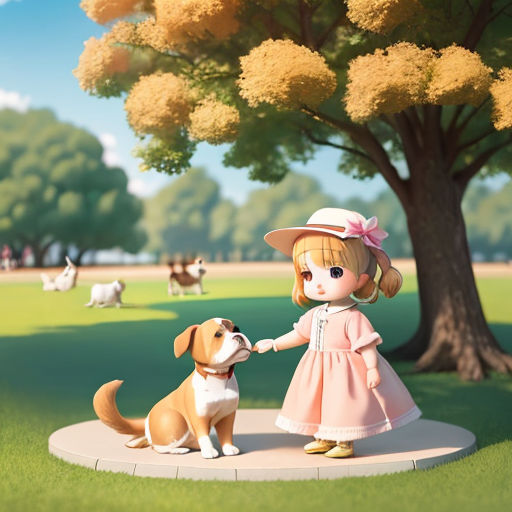
Buddy and Me: Understanding American Bulldogs
By Storybird

10 Jun, 2023

Understanding your American Bulldog can take some time and patience, but it is a rewarding process that will help you build a strong bond with your canine companion. This chapter will help you understand the breed's temperament, as well as recognizing signs of stress, excitement, and other emotions, allowing you to better communicate with your dog.

The American Bulldog is a powerful, athletic, and intelligent breed with a strong work ethic and a loyal disposition. They were originally bred for working tasks such as guarding livestock and hunting wild pigs, which required strength, agility, and tenacity. These traits are still present in the breed today, making them excellent working dogs as well as loving family pets.

The temperament of the American Bulldog can vary widely among individual dogs. Some may be more outgoing and boisterous, while others may be more calm and reserved. In general, however, American Bulldogs are affectionate, friendly, and people-oriented dogs who thrive on human companionship. They are also known for being highly trainable, due to their intelligence and desire to please their owners.

In order to understand your American Bulldog's emotions, it is important to observe their body language and behavior. This can give you valuable clues about how they are feeling, and help you respond appropriately. For instance, a wagging tail and a relaxed, loose, body posture are signs of happiness and contentment, while a tucked tail and lowered body posture may indicate fear or stress.

When an American Bulldog is excited or playful, you may notice a few behaviors such as jumping, barking, and tail wagging. An excited dog might also have their ears perked up and their body leaning forward, with a play-bow position. This is a signal for play and engagement, and is a great opportunity for you to engage in some fun activities with your dog, such as playing fetch or tug-of-war.

On the other hand, signs of stress or anxiety in your American Bulldog might include excessive panting, drooling, pacing, or trembling. Your dog may also try to avoid eye contact, or the whites of their eyes may be visible. It is important to address these signs of stress promptly, in order to prevent your dog from becoming more anxious or developing behavioral issues.

Socialization is a crucial aspect of understanding your American Bulldog and ensuring that they are well-adjusted. Exposing your dog to a variety of people, animals, and environments at a young age can help prevent potential aggression or fearfulness later in life. A well-socialized American Bulldog will be more confident and better equipped to handle new situations and experiences.

Training is another vital component for understanding and communicating with your American Bulldog. A well-trained dog is easier to manage and will be a more enjoyable companion. Training sessions also provide an opportunity for mental stimulation, which is essential for keeping your dog's mind sharp and preventing boredom-related issues such as destructive chewing or digging.

Positive reinforcement training methods work best for American Bulldogs, as they respond well to praise and rewards. This training approach builds trust and strengthens the bond between you and your dog, as they learn to associate good behavior with positive outcomes. Be sure to remain consistent with your training and expectations, as inconsistency can confuse your dog and slow their progress.

Keep in mind that American Bulldogs are a high-energy breed and require daily physical activity to stay healthy and happy. Regular walks, playtime, and interactive toys can help keep your dog engaged and burn off excess energy. Managing your dog's energy levels can also reduce the likelihood of problematic behaviors stemming from pent-up energy or boredom.

Just like humans, American Bulldogs can have unique personalities and quirks. It is important to get to know your specific dog and their individual preferences, as this will help you tailor your approach to training, socialization, and exercise accordingly. Some Bulldogs may be more food-motivated, while others may prefer praise or play as rewards for good behavior.

Communication is key to understanding your American Bulldog. Pay close attention to their body language, vocalizations, and behavior in order to gain insight into their emotions and needs. By doing so, you can respond appropriately and build a strong, trusting bond with your canine companion.

With patience and dedication, it is possible to develop a deep understanding and connection with your American Bulldog. Remember to provide consistent training, socialization, and exercise to ensure your dog's well-being. Ultimately, your efforts will be rewarded with a loyal, loving, and well-adjusted companion who will bring joy and happiness to your life.

Caring for an American Bulldog also requires attention to their unique health needs. Due to their stocky build and brachycephalic (short-nosed) facial features, they can be more susceptible to certain health issues, such as hip dysplasia and breathing problems. Regular veterinary check-ups and proper care can help prevent or manage these issues and ensure that your dog stays healthy and happy for years to come.

In conclusion, understanding your American Bulldog's temperament, emotions, and behaviors is essential for building a strong bond with your dog. By being attentive to their body language and needs, providing consistent training, socialization, and exercise, and addressing any health concerns, you can help your American Bulldog grow into a well-rounded, happy, and loyal companion.